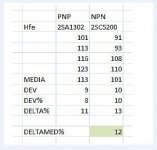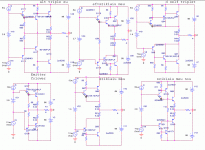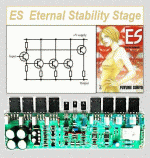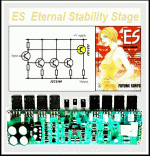new audio performace
Lineup are in this community with a great value
supports your passion
the pain passes with time and music can help you
I think the project has evolved to high levels
we can pass the test of sound now
I have tested NTE37 but are very different between them
so the best matching is between recent and past:
TOSHIBA 2SC5200 and 2SA1302 --> 12%
to avoid problems of stability and emphasys
I think it is important to give high priority to the gain of final quad
also in my testing found an RF solution with a little coil
between driver's common emitters and output line
(just in case of panic)
my last idea to improve this masterpiece is
adding a little switch to select two biasing:
Class AB or Class A regime
Lineup are in this community with a great value
supports your passion
the pain passes with time and music can help you
I think the project has evolved to high levels
we can pass the test of sound now
I have tested NTE37 but are very different between them
so the best matching is between recent and past:
TOSHIBA 2SC5200 and 2SA1302 --> 12%
to avoid problems of stability and emphasys
I think it is important to give high priority to the gain of final quad
also in my testing found an RF solution with a little coil
between driver's common emitters and output line
(just in case of panic)
my last idea to improve this masterpiece is
adding a little switch to select two biasing:
Class AB or Class A regime
Attachments
Can I say something good : ) ?
Put triple "stage" for output stage .The thd will go lower because of the high impedance of the stage .The base current from the output stage is loading the vas in an neliniar way.So ,if you will add an "stage" between the vas and output the input impedance will go lower like the thd.. like the triplet output . I tried this thing ant the sound is bigest improvement .Take a look and implement if you want .From left to right the 2-nd ant 6 stage has lower thd from all .
I think that it is not so important the thd in sinusoidal regim .Think that important is the distortion in dinamic regim(music) .Those distortion depends of the slew rate anf the thd .
Put triple "stage" for output stage .The thd will go lower because of the high impedance of the stage .The base current from the output stage is loading the vas in an neliniar way.So ,if you will add an "stage" between the vas and output the input impedance will go lower like the thd.. like the triplet output . I tried this thing ant the sound is bigest improvement .Take a look and implement if you want .From left to right the 2-nd ant 6 stage has lower thd from all .
I think that it is not so important the thd in sinusoidal regim .Think that important is the distortion in dinamic regim(music) .Those distortion depends of the slew rate anf the thd .
Attachments
Triple output is used by M. Leach
http://users.ece.gatech.edu/~mleach/lowtim/
and
http://users.ece.gatech.edu/~mleach/superamp/
True is that this way VAS will have know an easy load and work better.
http://users.ece.gatech.edu/~mleach/lowtim/
and
http://users.ece.gatech.edu/~mleach/superamp/
True is that this way VAS will have know an easy load and work better.
Bias on each output device is about 60mA.
It could be the bias generator. The bias voltage only wanders about .7mV at full output power. The currents of R7 and R8 "meet in the middle" at 2.5mA and peak at about 5mA.
Apart from that, maybe japanese transistors are magical.
This is just simulation, don't know what will happen in real life.
- keantoken
It could be the bias generator. The bias voltage only wanders about .7mV at full output power. The currents of R7 and R8 "meet in the middle" at 2.5mA and peak at about 5mA.
Apart from that, maybe japanese transistors are magical.
This is just simulation, don't know what will happen in real life.
- keantoken
If its 60ma its fine, can you put up the lt file here, interesting such a simple design is showing such good figures.
Let me give an example, lately there is quite a stir going on about diamond output topologies, I havent simmed them, but I suspect that those outputs run on very high idle currents, and therefore show good figures, this can be done with conventional outputstage and same figures or even better can be had using the same idling currents, thats why i dont see the point of it. The bryston outputstage is nothing special, in fact I find the cfp ef better but at the moment Im not seeing how the design can have such good figures.
Let me give an example, lately there is quite a stir going on about diamond output topologies, I havent simmed them, but I suspect that those outputs run on very high idle currents, and therefore show good figures, this can be done with conventional outputstage and same figures or even better can be had using the same idling currents, thats why i dont see the point of it. The bryston outputstage is nothing special, in fact I find the cfp ef better but at the moment Im not seeing how the design can have such good figures.
It's not very surprising to me, since I get distortion figures similar to this regularly in the sim. So there are 3 possibilities:
1: I am doing something wrong.
2: I have learned how to make the simulator spit out "pretty" numbers.
3: I have actually learned a lot from the simulator and the distortion figures are accurate.
This is the file. All the required models should be in the text file I posted earlier.
I'm thinking that if used properly, the Bryston output is very conducive to AB switching. The Bryston is basically a CFP/Darlington combo and there is feedback to both emitters.
Note: the change the input frequency, change the .param statement.
- keantoken
1: I am doing something wrong.
2: I have learned how to make the simulator spit out "pretty" numbers.
3: I have actually learned a lot from the simulator and the distortion figures are accurate.
This is the file. All the required models should be in the text file I posted earlier.
I'm thinking that if used properly, the Bryston output is very conducive to AB switching. The Bryston is basically a CFP/Darlington combo and there is feedback to both emitters.
Note: the change the input frequency, change the .param statement.
- keantoken
Attachments
TOSHIBA 2SC5200 and 2SA1302
Those are a"mismatch"... 2sc5200's "partner" is 2SA1943
(fairchild fjl4215/4315)
And 2SA1302 compliment is 2SC3281 -discontinued or "fakes'
very rare unless stripped from OEM.
(modern equivalants
mjl4321/mjl4302 ,njw0321/0302 - ON semi.)
OS
Ok I had a quick look at the design, I find that it is oscilating, the current through the output trannies is in microamps and q8 q7 is around 2ma at idle. Ill have to get it stable first and see what is the optimum bias for the outputstage is before making any other comments, but it shouldnt be build just yet, you are going to run into some serious problems although it does show potencial for the THD is rather low.
.
.
Match the BJT
yes is true
but have you try to match this recent partner?
value are so far! (2X - 5X)
best wedding is 2SA1302 and 2SC5200 at the moment
or modern PNP equivalent i think

ostripper said:
Those are a"mismatch"... 2sc5200's "partner" is 2SA1943
(fairchild fjl4215/4315)
And 2SA1302 compliment is 2SC3281 -discontinued or "fakes'
very rare unless stripped from OEM.
(modern equivalants
mjl4321/mjl4302 ,njw0321/0302 - ON semi.)
OS
yes is true
but have you try to match this recent partner?
value are so far! (2X - 5X)
best wedding is 2SA1302 and 2SC5200 at the moment
or modern PNP equivalent i think
in any case
need matched pair
this picture comes from A-700
http://www.esafono.it/a700.pdf
...easy to modify
Kean
have you draw PCB of Lyra?
need matched pair
this picture comes from A-700
http://www.esafono.it/a700.pdf
...easy to modify
Kean
have you draw PCB of Lyra?
Attachments
I have tried a super Dx amplifier tweaking for low distortions Beto
and using Multisim 10 i could make it very low in distortion... was hardly modified.... then i have assembled and sounded awfull.
Also we had some experience using Cygnus in our country.... Cygnus specifications were great (despite it is a copy of Leach Amplifier).... but both of us have junked the unit as resulted not good... the reproduction quality were not the one we were specting.
After thousands amplifiers made and listened i could not confirm that low distortions results in good sonics.....now a days i have abandoned fourier analises .... building and listening searching for
sonic quality and not bothering anymore about numbers.
That STK chip we both have used and appreciated measure badly into simulators....but also there are some good units into measurements that produces nice sound, alike LM3866 and better one LM4780
Obsession by numbers started in 1978, and i could not see all that increase in sound quality since those early days... there are some old units from Marantz, measuring awfully that reproduces a very nice and pleasant sonics.,
The one will feel great with numbers are distortion analisers, scopes and spectrum analisers...but unfortunatelly instruments do not listen music and do not buy amplifiers...so.... build amplifiers to instruments happyness...good numbers for meters...is not a very good idea.... sound is for humans... audible performance..pleasant sonics for humans.
In other words Beto:
- "Don't ask simulators if the amplifier sounds fine, as they will not answer you... they do not listen you, they cannot talk and they cannot listen music alike humans can... they can just produce calculations... ask your niece... call friends... produce A to B comparisons"
Simulators and instruments are nice tools..but not more than tools... they are not humans..so, cannot answer things and evaluate things alike humans can.... sound reproduction is made for humans...to ears... to play music...not tones or bursts of tones
This text is a special contribution to your development and to jump over some stages of learning were we loose a lot of time... waste of time to produce two circuits into simulators and ask fourier what they sound....non sense in my point of view as the time waste is enougth to build those two circuits and to listen them into real life...so...it is an artificial, non real thing when you can do the real thing.
There are some myths in audio too alike we had in Radio Amateurs works... do your remember that increase in supply current capabilities to increase Radio Frequency power output... do you remember that foolish?... we have some of those things in our communitty too.... audio cables and a lot of stuff are also having addicted guys here..... do you remember... radio consumption was 5 amperes and people saying that became better when using 50 amperes supply with a stone inside?
Those guys that uses simulators, do that because cannot do different... some of them has some movement problems, others, alike old Line up (very old with 57!) cannot use soldering iron because his place is so cold the soldering iron only warms...ahahahahahahah!
regards,
Carlos
and using Multisim 10 i could make it very low in distortion... was hardly modified.... then i have assembled and sounded awfull.
Also we had some experience using Cygnus in our country.... Cygnus specifications were great (despite it is a copy of Leach Amplifier).... but both of us have junked the unit as resulted not good... the reproduction quality were not the one we were specting.
After thousands amplifiers made and listened i could not confirm that low distortions results in good sonics.....now a days i have abandoned fourier analises .... building and listening searching for
sonic quality and not bothering anymore about numbers.
That STK chip we both have used and appreciated measure badly into simulators....but also there are some good units into measurements that produces nice sound, alike LM3866 and better one LM4780
Obsession by numbers started in 1978, and i could not see all that increase in sound quality since those early days... there are some old units from Marantz, measuring awfully that reproduces a very nice and pleasant sonics.,
The one will feel great with numbers are distortion analisers, scopes and spectrum analisers...but unfortunatelly instruments do not listen music and do not buy amplifiers...so.... build amplifiers to instruments happyness...good numbers for meters...is not a very good idea.... sound is for humans... audible performance..pleasant sonics for humans.
In other words Beto:
- "Don't ask simulators if the amplifier sounds fine, as they will not answer you... they do not listen you, they cannot talk and they cannot listen music alike humans can... they can just produce calculations... ask your niece... call friends... produce A to B comparisons"
Simulators and instruments are nice tools..but not more than tools... they are not humans..so, cannot answer things and evaluate things alike humans can.... sound reproduction is made for humans...to ears... to play music...not tones or bursts of tones
This text is a special contribution to your development and to jump over some stages of learning were we loose a lot of time... waste of time to produce two circuits into simulators and ask fourier what they sound....non sense in my point of view as the time waste is enougth to build those two circuits and to listen them into real life...so...it is an artificial, non real thing when you can do the real thing.
There are some myths in audio too alike we had in Radio Amateurs works... do your remember that increase in supply current capabilities to increase Radio Frequency power output... do you remember that foolish?... we have some of those things in our communitty too.... audio cables and a lot of stuff are also having addicted guys here..... do you remember... radio consumption was 5 amperes and people saying that became better when using 50 amperes supply with a stone inside?
Those guys that uses simulators, do that because cannot do different... some of them has some movement problems, others, alike old Line up (very old with 57!) cannot use soldering iron because his place is so cold the soldering iron only warms...ahahahahahahah!
regards,
Carlos
Attachments
- Status
- This old topic is closed. If you want to reopen this topic, contact a moderator using the "Report Post" button.
- Home
- Amplifiers
- Solid State
- italian style






